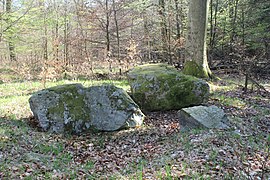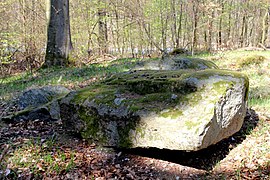Mor Gribs Hule

Mor Gribs Hule ( German "Mother Gribs Cave" ) is located south of the village of Kagerup in the Grib Skov (forest) southeast of Helsinge and north of Hillerød not far from Helsingevej on the Danish island of Zealand . It is a megalithic system of the Funnel Beaker Culture (TBK), which dates from 3500 to 2800 BC. BC originated. The passage grave is a form of Neolithic megalithic systems, which consists of a chamber and a structurally separated, lateral passage. This form is primarily found in Denmark, Germany and Scandinavia, as well as occasionally in France and the Netherlands. Neolithic monuments are an expression of the culture and ideology of Neolithic societies. Their origin and function are considered to be the hallmarks of social development.
In 1877 the later director of the National Museum Sophus Müller (1846–1934) saved the passage grave from destruction and placed it under a preservation order. It was last restored in 1990. The name is derived from a folk tale that tells of a sorceress, Mother Grib, who lured travelers astray and had their sons robbed and killed.
- Mor Gribs Hule
description
The chamber of the complex is located in a rounded hill without edging. It is about five meters long and 2.7 m wide and is framed by 16 bearing stones, while all cap stones are missing. The passage starting in the east is about 4.5 m long and at the inner end 0.5 m wide. Its capstones are also missing, while the 13 bearing stones have been completely preserved and were mostly found in situ . There is a forest parking lot across the street. The intermediate masonry has been restored and in some places they are small because the bearing stones are sometimes very close.
The excavation showed a well-preserved complex, the bottom of which apparently consisted of a layer of crushed flint up to 20 cm thick . Later it turned out that this was not the bottom layer, but part of a filling layer. At one point in the chamber, larger tiles were found that formed a quarter (Danish: Gulvinddelinger). The purpose of the quarters is still unclear, but similar tiles have been found in Odder in eastern Jutland , among others, and they are particularly numerous in the grounds in Mecklenburg and Sweden . The stones separated a section of the chamber and differed from the large stone slabs of the rest of the paving that was found in the passage grave. For conservation reasons, the entire pavement is now under a layer of gravel.
about 140 m away is the megalite grave in Gribskov, which has been stripped of its stones
- Megalite grave in Gribskov
See also
literature
- Torben Dehn, Svend I. Hansen, Flemming Kaul: Klekkendehøj og Jordehøj. Restaureringer og undersøgelser 1985-90 (= Stenaldergrave i Danmark. Vol. 2). Nationalmuseet, Copenhagen 2000, ISBN 87-7279-146-2 .
- Ingrid Falktoft Anderson: Vejviser til Danmarks oldtid . 1994, ISBN 87-89531-10-8 , p. 265
Individual evidence
- ^ Johannes Müller : Neolithic Monuments and Neolithic Societies. In: Hans-Jürgen Beier , Erich Claßen, Thomas Doppler, Britta Ramminger (eds.): Varia neolithica VI. Neolithic Monuments and Neolithic Societies. Contributions from the meeting of the Neolithic Working Group during the annual meeting of the North-West German Association for Ancient Research in Schleswig, 9. – 10. October 2007 (= contributions to the prehistory and early history of Central Europe. Vol. 56). Beier & Beran, Langenweißbach 2009, ISBN 978-3-941171-28-2 , pp. 7-16, here p. 15.
Web links
Coordinates: 55 ° 58 ′ 48.4 ″ N , 12 ° 17 ′ 22.6 ″ E







